Transconjunctival blepharoplasty is a type of lower eyelid blepharoplasty.
In transconjunctival blepharoplasty, a tiny incision is made along the inner side of the lower eyelid, which is called the conjunctiva.
The technology allows you not to worry about the risk of scarring on the skin. There are no traces left after the intervention. This technique is called seamless.
In addition, the transconjunctival approach eliminates side effects associated with shape deformations, rounding and eversion of the eyelid. The surgeon easily penetrates the fatty spaces and correction of the nasolacrimal groove becomes more effective. It should be understood that in the upper eyelids, surgical access through the conjunctiva is impossible.
Indications ↑
Traditional blepharoplasty, in comparison with transconjunctival one, involves incisions that subsequently leave sutures or scars.
Differences between traditional and transconjunctival blepharoplasty
After transconjunctival blepharoplasty, the face looks younger, and signs of fatigue and fine wrinkles around the eyes completely disappear. Therefore, there are many positive reviews about the effective outcome of transconjunctival blepharoplasty.
Transconjunctival blepharoplasty is recommended in the presence of the following pathologies:
- facial wrinkles around the eyes;
- deep nasolacrimal groove;
- horizontal fold parallel to the lower eyelid;
- overhanging dermis;
- small hernias;
- bags and dark circles under the eyes;
- decreased firmness and elasticity of the skin of the lower eyelid.
The ideal patient for this procedure is one who has minimal excess skin of the lower eyelids, but there is protrusion of subcutaneous fat.
The use of this method will not solve all problems of eyelid deformation. Transconjunctival blepharoplasty is not suitable for all patients. If the dermis has excessive excess and deep wrinkles, it is more effective to choose traditional blepharoplasty of the upper and lower eyelids or laser techniques.
Contraindications ↑
Operation is prohibited if the following factors exist:
- dry eye syndrome;
- infections and inflammations in the eyes;
- chronic eye diseases (retinal dystrophy, glaucoma);
- disorders in hemostasis (blood clotting);
- diabetes mellitus;
- pregnancy and lactation;
- oncology.
Progress of the operation ↑
Before transconjunctival blephoroplasty, the patient undergoes preoperative preparation.
During this period you should:
- carefully study reviews of other clients about the blade and reviews from the surgeon;
- come for a consultation with an ophthalmologist and surgeon;
- take blood tests;
- undergo examinations (ECG, fluorography);
- stop painkillers, anti-inflammatory drugs and anticoagulants, including aspirin;
- go on vacation for about 2 weeks to fully recover after surgery;
- limit the consumption of alcoholic beverages and junk food;
- ask relatives or friends for support after the operation.
It is possible to use both general and local anesthesia, depending on the indications and sensitivity. Using a scalpel, the surgeon makes an incision along the inner surface of the lower eyelid through the conjunctiva and excess fatty tissue is excised. Sutures are placed on the wound of the conjunctival membrane. Then a compressive bandage is placed over the eyes and removed after a few hours.
The duration of the manipulation is 1.5 hours. Usually after 5 hours the patient is sent home.
A - dissection of the conjunctiva and mobilization of fatty hernias
B - excision of fatty hernias
B — transplatation of fatty hernias relative to the edge of the orbital bone
Rehabilitation ↑
In the first hours after blepharoplasty, burning, tingling and slight pain are felt in the intervention area. Mild swelling disappears already on the 10th day. Doctors prescribe drops and healing ointments, which should be used throughout the recovery period. It is prohibited to apply cosmetics to the eyes and use contact lenses. Physical activity will have to be limited for 2 weeks. For a month you should avoid visiting the solarium, swimming pool, sauna and bathhouse. You need to sleep with your head raised up, and not on your side. Do not wet or touch the operated area.
At least six weeks must pass for the results to be fully assessed.
Before and after surgery
Before and after surgery
Laser technology ↑
Transconjunctival blepharoplasty is also performed using advanced laser equipment. Laser transconjunctival blepharoplasty is effective for small excess eyelid skin. The technique includes shallow grinding and fractional photothermolysis. During the procedure, the skin is “evaporated” by laser beams. Thermolysis does not require a long rehabilitation period. The method is considered bloodless; laser light coagulates and seals the vessels. This further minimizes the development of bruises and hematomas.
Advantages of technology ↑
The main advantages of transconjunctival blepharoplasty:
- without visible marks;
- healing takes less time;
- short rehabilitation period (about a week);
- minimum pain;
- lowest risk of side effects, especially scar tissue;
- more natural effect, unlike traditional blepharoplasty.
- positive patient reviews.
For certain pathologies, transconjunctival blepharoplasty and upper eyelid blepharoplasty are combined into one operation.
Cost of the operation ↑
The price of blepharoplasty varies depending on the clinic, the doctor's name and reputation, the anesthesia used and the equipment used. The average price is about 50,000 rubles.
Loss of facial attractiveness in the eye area is one of the most pressing age-related problems for most women. These include bags under the eyes and the appearance of dark spots. Ordinary creams, if they cope with the task of rejuvenation, do so for an extremely short period of time. The best option is transconjunctival blepharoplasty, thanks to which restoration of beauty is possible, while being more delicate compared to other types of surgical intervention.
Justification of the goals and objectives of the procedure
A procedure is performed to correct the eye area: in the process, fatty hernias are removed, the deformed skin of the eyelid is restored, and bags in the periorbital area are eliminated.
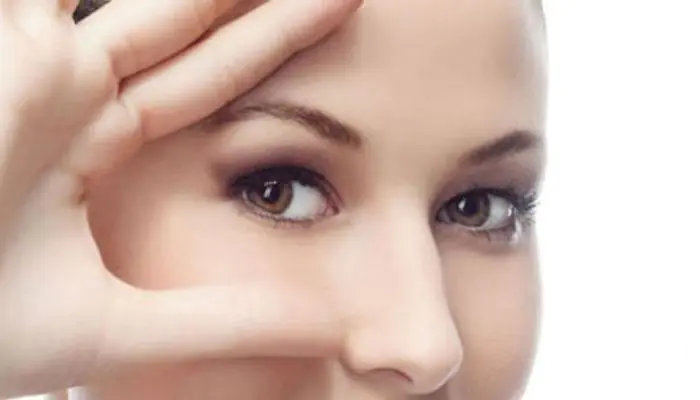
Surgical intervention is feasible for different age categories of people: from 30 to 70 years.
There are two types of blepharoplasty:
The difference lies in the way the therapy is carried out. In the case of transconjunctival, the result is achieved by cutting tissue. The prefix “trans” has the meaning of crossing something, in this case the mucous membrane of the eyelid.
The internal incision is relatively small in size, generally does not exceed 0.5 centimeters and is more like a puncture through which fat deposits are removed and redistributed. In this regard, the patient will not have any traces of the operation.
Advantages of the method
Unlike the traditional method of blepharoplasty, after transconjunctival surgery there are no scars or other signs of surgical intervention.
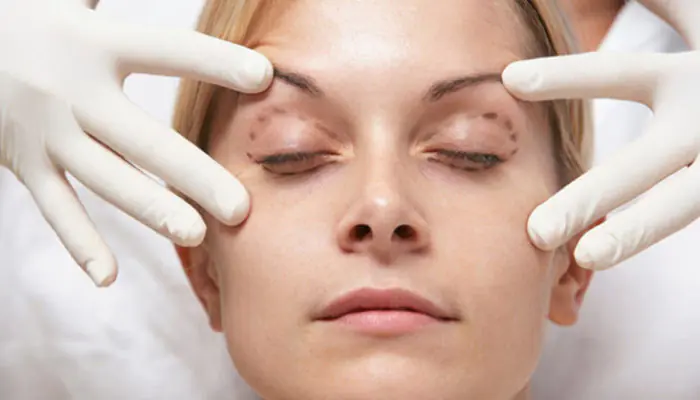
Taking into account that the specialist performs the operation under the eyelid, and not on top of it, the seams are invisible. The effect itself can be observed after 4 days.
During the procedure, the client does not experience pain, because the manipulations are carried out under local anesthesia. Thanks to this, the rehabilitation period is significantly reduced.
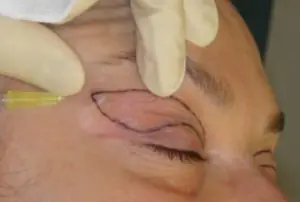
The advantages of this effect include an extremely low risk of making a medical error - the surgeon works exclusively with fatty tissues, without affecting the upper layer of the epithelium.
Despite the close location of the operated area to the eyes, blepharoplasty does not affect visual acuity, and the rehabilitation period is short.
To achieve a greater effect, a laser rejuvenation technique (fractional thermolysis) is used as a supplement in agreement with the client and on the recommendation of a doctor.
Indications for use
Most often, transconjunctival blepharoplasty is performed due to age-related changes, which result in skin atrophy and displacement of the subcutaneous layer of fatty tissue. However, sometimes relatively young women have to resort to surgical help.
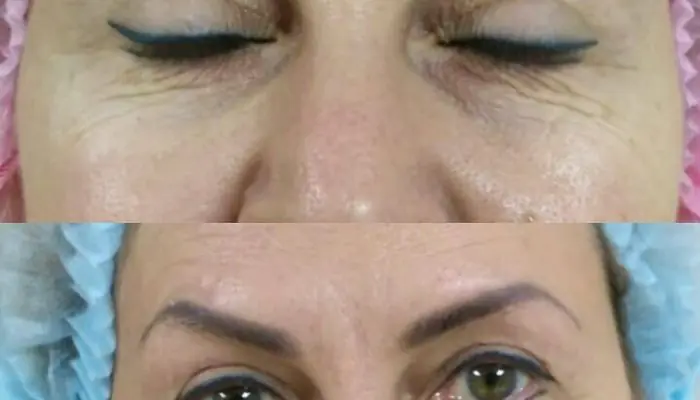
The main indications for aesthetic therapy include the presence of several defects.
- Deformation of the skin, resulting in displacement of the corners of the eyes.
- Hyperpigmentation in the periorbital zone.
- Bags under the eyes.
- Ptosis of the upper eyelid.
- Dark circles.
- Pronounced naso-zygomatic folds.
- The need for therapy for a bulging eyeball.
- Correction of the protrusion of the eyelid borders.
- Periorbital grooves.
- Horizontal wrinkles in the eye area.
Existing contraindications
Like any surgical intervention, transconjunctival blepharoplasty has a number of contraindications, the presence of which is identified during the initial consultation with the surgeon.
To avoid complications during rehabilitation, you will have to undergo a preliminary examination with the necessary tests.
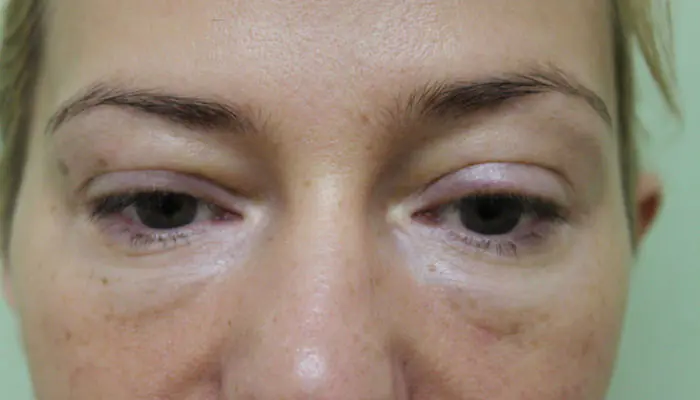
- pregnancy and lactation;
- low blood clotting coefficient;
- menstrual cycle (the contraindication is temporary and is due to a decrease in cell restoration functions during this period);
- oncology;
- viral diseases (ARVI, fever, elevated body temperature, etc.);
- chronic diseases in the acute stage (in some cases, surgery may be performed in remission, which should be discussed with your doctor);
- elevated blood sugar levels;
- herpes;
- autoimmune diseases;
- dry eye syndrome;
- dermatological diseases;
- problems with the thyroid gland.
Buyanov Sergey Yurievich (Expert Doctor):
Transconjunctival blepharoplasty of the lower eyelids is not recommended for people with overstretched skin that has lost its elasticity. Therefore, after the age of 35, the operation will not have an effect. New fat cells will rush to the sites where the fatty tissue is removed, and the space will fill up again.
Possible consequences
Complications after transconjunctival blepharoplasty are extremely rare and in most cases arise as a result of incorrect care during rehabilitation or negligence of the surgeon.
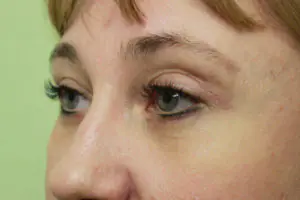
These may include:
- change in skin color in the affected area;
- suppuration;
- the formation of hematomas, which may result in vision problems due to the pressure exerted by blood clots on the optic nerve;
- dysfunction of tearing eyes (if the phenomenon occurs for more than a week, you should immediately contact the clinic);
- displacement of the upper eyelid due to nerve damage;
- problems with eyelid closure due to excessive removal of fatty tissue;
- impaired motor functions of the eyeball (diplopia);
- excessive sensitivity to light;
- eversion of the eyelid due to incorrect skin tension;
- glaucoma.
Description of the stages of the procedure
The duration of the operation often does not exceed 1.5 hours. During the manipulations, the client does not feel anything, and after a few hours, accompanied by loved ones, he can go home.
There is one caveat: the patient will not be able to get to his destination on his own, because a blindfold is applied to his eyes.
The procedure involves two methods:
- using a medical scalpel;
- laser method.
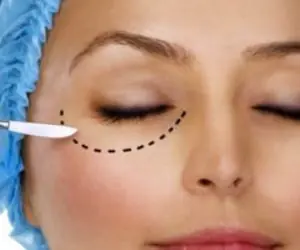
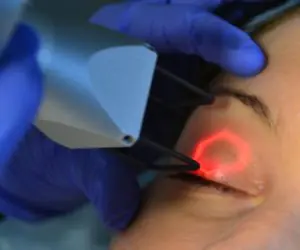
Transconjunctival blepharoplasty of the upper and lower eyelids has a number of individual features associated with anatomical characteristics. The procedure is carried out in one step and does not require a repeated session for a long time - the result lasts for up to 7 years.
Upper eyelid blepharoplasty
After the anesthesia has taken effect, the specialist makes a small incision on the inside of the eyelid, through which the endoscope is inserted. It is used to lift the eyebrows, as a result of which the relief of skin folds in the periorbital zone changes.
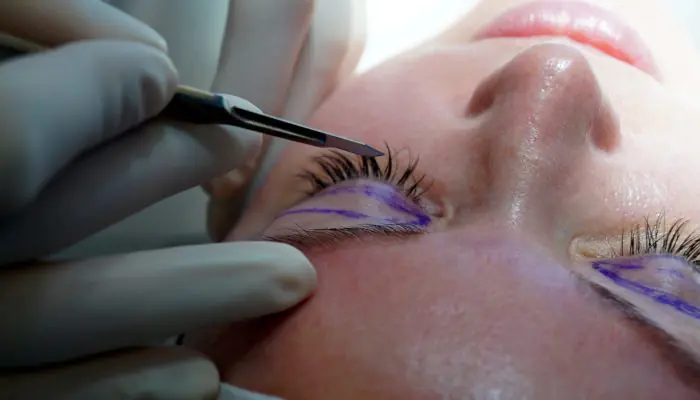
For older clients, it is possible to use implants that help maintain the skin and affect the duration of the effect of the operation.
Lower eyelid blepharoplasty
The process takes place the same way - without excision of the upper layers of the dermis. During the operation, the doctor makes an incision in the conjunctiva, through which the fat sac is removed.
Buyanov Sergey Yurievich (Expert Doctor):
In other words, through a small hole, the surgeon pumps out fluid and fat. Does not perform any other manipulations using surgical instruments.

Rehabilitation period
Considering that the operation is low-traumatic, the rehabilitation period is also relatively short.
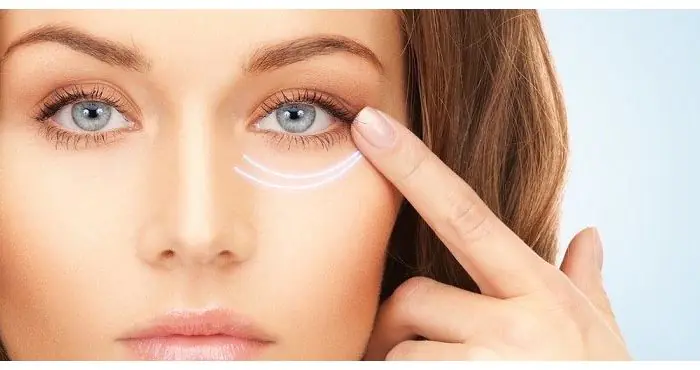
On average, after 7-10 days, the unpleasant sensations completely disappear, and if the circumstances are good, on the 3rd day it is possible to remove the internal sutures (depending on the individual ability of the cells to recover).
To avoid complications, a number of recommendations should be followed.
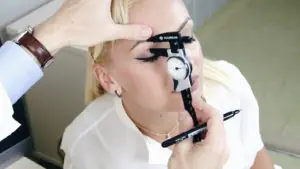
- Try to limit the stress on the body as a whole as much as possible, incl. and on the eyes. Stop going to the gym, saunas, reading books and watching TV.
- Try to avoid exposure to sunlight and ultraviolet rays (sunbathing and visiting a solarium are strongly discouraged). If blepharoplasty was done in the summer, use sunglasses. These conditions must be observed for at least 14 days.
- Don't take hot showers.
- If you have vision problems and wear contact lenses, you will have to temporarily replace them with glasses so as not to touch the conjunctiva once again during the recovery process.
- Do not use decorative cosmetics. After a week, it is possible to use hypoallergenic makeup products.
Photos before and after
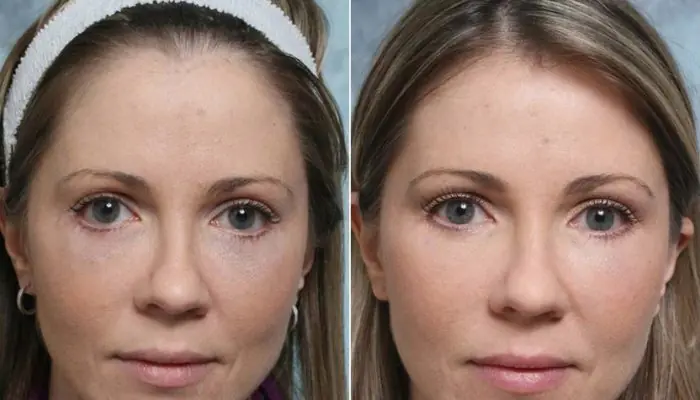
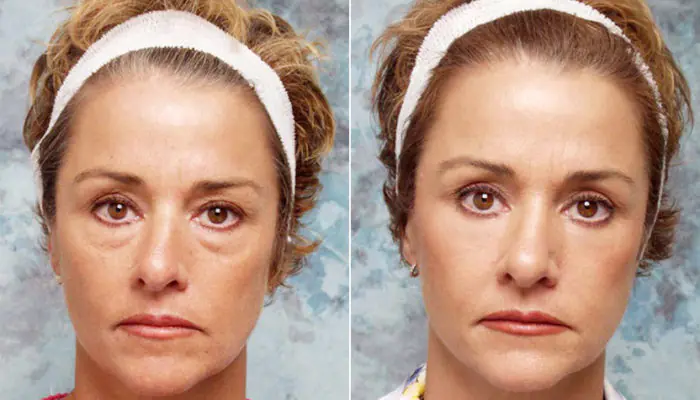
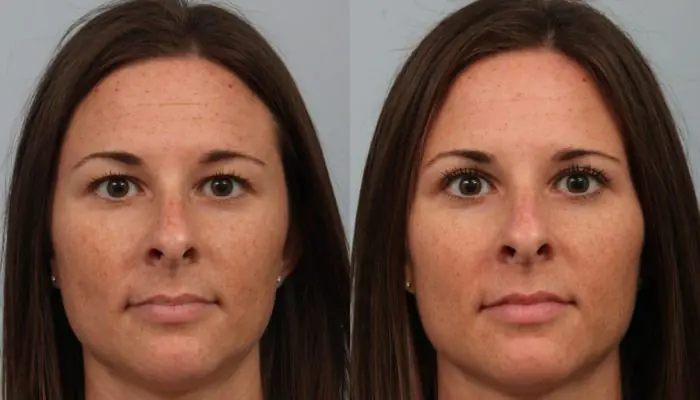
Cost of blepharoplasty
If you decide to have blepharoplasty, choose a clinic with special care - read reviews on forums, ask your friends.
Despite the fact that the level of injury during surgery is relatively low, an inexperienced specialist can cause considerable damage to your health.
The final cost of the procedure varies depending on the complexity of the upcoming operation, the qualifications of the surgeon and a number of other factors.
Let's consider the pricing policy in different cities.
Moscow
The Klazko Aesthetic Medicine Clinic offers blepharoplasty services for the upper or lower eyelids for 70,000 rubles.
When performing a complex circular operation, a discount of RUB 20,000 is provided.
Addresses of Klazko centers:
- St. Malaya Gruzinskaya, 20/13, building 1, tel. 8 (495) 369-61-77.
- Rublevo-Uspenskoe highway, 123B, tel. 8 (499) 648-11-29.
A more affordable price at the Bios clinic, which has been specializing in aesthetic medicine since 1993 and ranks 1st in the ranking. Here you can transform yourself for an amount starting from 54,000 rubles.
It is located at the address: Ivankovskoe highway, no. 7, tel. 8 (495) 518-62-85.
Kazan
Kazan price tags are distinguished by lower indicators and begin to rise from 10,000 rubles.
Clinics and centers in Kazan:
- Clinic "Mart". Address: Yamasheva Ave., 54, tel. 8 (843) 295—55-66 (cost for the upper eyelid - from 10,000, for the lower - from 14,000).
- Primamed Clinic. Address: st. Kommunarov, 2, tel 8 (843) 518-14-84 (cost 18,000/23,000 rubles).
- Clinic "The Platinental". Address: st. Karl Marx, 48, tel 8 (843) 236-66-66 (cost 42,000/130,000 rubles).
Ekaterinburg
Prices for blepharoplasty in Yekaterinburg have also moved not far from Kazan. On average, a service for correcting the upper eyelid starts from 18,000 rubles, and the lower eyelid starts from 20,000 rubles.
Institutions providing aesthetic surgery services:
- MC "Doctor Plus". St. Kuibysheva, 10, tel. 8 (343) 212-06-06.
- Clinic "Estevita". St. Radishcheva, 33, tel. 8 (343) 287-44-33.
- Clinic "Estyline". St. Popova, 33A, tel. 8 (343) 359-40-42.
- MC "Harmony". St. Tveritina, 16, tel. 8 (343) 254-66-66.
Krasnodar
A higher price can be seen for blepharoplasty in Krasnodar. In this city, the minimum cost for transformation starts from 55,000 rubles.
- "Chalet Santé" St. Red Partisans, no. 238. Phone for inquiries: 8 (800) 222-37-34.
- MC "Esthetik Med" St. Oleg Koshevoy, 155. Phone for inquiries: 8 (989) 812-22-23.
- Laser Medicine Center. St. Severnaya, no. 600/1. Phone for inquiries: 8 (861)254-00-77.
Minsk
The pricing policy for blepharoplasty in Minsk is an order of magnitude lower than that presented in the Russian Federation, which is why many turn to clinics in Belarus - here eyelid correction will cost from 450 rubles.
- MC "Kravira". St. Skripnikova, 11V.
- MC "Confidence". St. Pritytskogo, 39.
- MC "Edaran Medical". St. Lenina, 9.
Ryazan
The average price for correction of the periorbital zone in Ryazan is 25,000 rubles. The operation can be performed in the following clinics:
- MC "M-Clinic". St. Uritskogo, 45, lit. A1. Phone: 8 (953) 736-04-04.
- MMC "On Clinic". St. Kudryavtseva, 56. Phone: 8 (4912) 70-08-80.
- Clinic of actual cosmetology. St. Radishcheva, 11. Phone: 8 (4912) 95-28-28.
Reviews from cosmetologists
This procedure is characterized by a low level of trauma and does not require expensive equipment, and the results last a long time.
Negative reviews regarding transconjunctival blepharoplasty are very rare.
A plastic surgeon’s reasoning regarding the demand for the procedure:

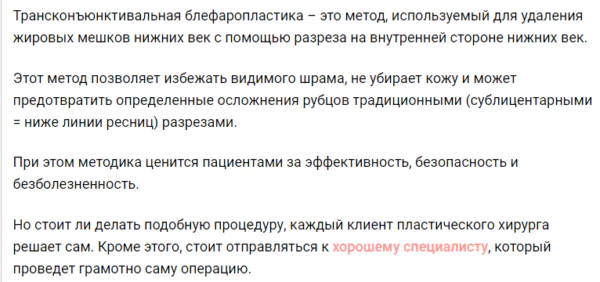
Advice from the leading specialist of the “Health” clinic (Moscow) Z. M. Gimbatova regarding the rehabilitation period:
Pronounced aesthetic defects in the periorbital zone treacherously betray age and make the face painful and tired. Bags under the eyes, wrinkles, drooping eyelids - there comes a time when cosmetics are no longer able to disguise such problems. The solution is plastic surgery, but you need to decide which technique to give preference to.
Transconjunctival blepharoplasty is one of the most popular methods of surgical eyelid correction; it is also often called “sutureless”. Its main feature is that the incisions are made not from the outside, but from the inside, along the conjunctiva of the eye. Due to this, the scars remain practically invisible in the future. How effective and safe is such an operation, what problems will it help to cope with? What are its pros and cons, and who, unfortunately, is it not suitable for? TecRussia.ru talks about all the subtleties:
How does it differ from the classical method: advantages and disadvantages
The main advantages of eyelid correction using transconjunctival access are as follows:
- The outer layer of skin is not damaged, which avoids visible scars. With classic blepharoplasty, the incision is made from the outside, along the eyelash line, due to which the stitches can be clearly visible in the future.
- Less traumatic, the result looks very natural.
- Short recovery period – no more than 1.5-2 weeks.
- Low likelihood of complications. In particular, the risk of ectropion (inversion of the eyelid) is minimal.
Contrary to the fears of patients who are concerned about the proximity of the manipulations to the eyeball, the operation does not threaten it with injury and does not affect vision. However, this technique also has its disadvantages:
- Dalkeo, not all aesthetic problems in the eyelid area can be corrected using a seamless method: for example, it will not help eliminate severe ptosis of the lower fold.
- The shorter duration of the result is about 5-6 years, while with classical plastic surgery it lasts up to 10 years.
Who is the seamless technique suitable for?
The following defects can be corrected using transconjunctival lift:
- moderate sagging skin in the periorbital area;
- slight drooping of the lower eyelid, hernial protrusions;
- “bags” under the eyes caused by excessive stretching of the skin;
- drooping upper eyelid.
These problems arise not only due to natural aging: they occur in patients of different ages and can be caused by heredity or concomitant diseases.
At the same time, the most effective operation will be if it is performed at about 30–35 years old, when the skin on the eyelids is still quite elastic. If it is overly stretched, there are obvious excesses, severe hernias or wrinkles, seamless correction will be ineffective - therefore, after 45, you cannot expect a good result from it: in this case, the method of choice will be classic blepharoplasty.
How is the operation performed?
Any surgical procedures, even low-traumatic and gentle ones, require a preliminary examination. Among the mandatory ones are general and biochemical blood and urine tests, and consultation with an ophthalmologist. Additional ones are determined by the surgeon depending on the complexity and volume of the intervention, the condition and age of the patient. Also, when preparing for blepharoplasty, it is important follow the following recommendations:
- 3-4 weeks before - stop taking NSAIDs and blood thinning drugs (Aspirin, Warfarin, Heparin).
- For half a month - refuse to visit the solarium or the beach. When exposed to the sun, use protective glasses.
- For 3-5 days - avoid drinking alcohol, do not smoke.
- When planning an operation, it is advisable to take at least 1 week of rest after it: this will allow the body to fully recover and avoid complications.
The duration of transconjunctival blepharoplasty is 0.5-1.5 hours (depending on the required amount of work), quite often it is performed under local anesthesia. In some cases, usually when both eyelids are corrected at the same time, the patient may be put into a state of medicated sleep. Intervention scheme:
- Performing preliminary markings in the correction zone.
- Anesthesia of the surgical site using injections of anesthetics and Adrenaline (Epinephrine).
- When a sufficient degree of numbness occurs, the surgeon performs a dissection of the tissue on the conjunctiva. Currently, the generally accepted standard is to use a laser beam rather than a scalpel for this purpose: under the influence of light energy, the vessels coagulate, preventing bleeding.
- Using an endoscope, the doctor removes excess fat bags and, if necessary, performs tissue tightening.
- The edges of the surgical wound are sutured with self-absorbing sutures. Sometimes the doctor can do without them - very short incisions will heal on their own.
- An ointment is applied to the eyes to prevent dryness. On top there is a special bandage.
Upon completion of the operation, the patient remains under the supervision of medical personnel for 6-8 hours. Then, if there are no complications, you can go home.
How is recovery going?
Due to the low invasiveness of the method, rehabilitation time is reduced to
8-10 days. During this period, there are a number of simple rules, the observance of which is necessary for healing to take place without any problems. In addition, doctors advise sticking to some restrictions longer. Basic recommendations:
- For the first week, you need to follow a gentle regimen with minimal physical activity, and also eliminate any strain on the eyes: watching TV, working at the computer, and reading books are prohibited.
- It is advisable to sleep with the head of the bed raised or on a high pillow - this will help reduce the severity of swelling.
- For 1-2 months, doctors advise wearing sunglasses when going outside - at any time of the year. Contact lenses are allowed to be used only 3 weeks after surgery.
- After 10-12 days you can start using cosmetics. Give preference to products marked “hypoallergenic”.
- After 3 weeks, you are allowed to sunbathe on the beach and go to the solarium.
- Sauna, steam bath, hot shower are prohibited for a month.
Sutures are usually removed on days 4–6. To prevent the formation of rough scars, it is not recommended to rub your eyes or stretch your eyelids for at least 1 month. During the first 3-4 days after the intervention, hematomas and swelling increase; normally, they last up to 2 weeks and go away on their own. To speed up this process and prevent complications, it is important to properly care for the operated area:
- regularly treat seams with an antiseptic;
- use creams or ointments with regenerating properties (for example, Levomekol);
- you can apply cold compresses to reduce swelling - but their frequency must be agreed upon with the surgeon;
- To prevent dryness and inflammation of the eyes, the use of special drops, for example Tobrex, is allowed.
You can make a preliminary assessment of the aesthetic result already on the 4-5th day, when the swelling begins to go away, and make final conclusions after 3-4 weeks.
Contraindications, possible complications and side effects
Transconjunctival blepharoplasty is not performed in the presence of the following pathologies and conditions:
- exacerbation of chronic, infectious diseases;
- problems with blood clotting;
- increased intracranial and intraocular pressure;
- diabetes mellitus, other endocrinological pathologies;
- malignant neoplasms;
- immunodeficiency conditions (AIDS, HIV);
- xerosis (dryness) of the eye;
- pregnancy, breastfeeding period.
When choosing a date for surgery, a woman’s menstrual cycle is taken into account - the intervention should not be carried out during menstruation.
The appearance of aesthetic and/or functional complications is usually due to the low competence of the doctor and the patient’s failure to comply with the surgeon’s recommendations during the recovery period. The most common problems:
- infection in the periorbital zone with subsequent inflammation and suppuration;
- increased dryness of eyes, lacrimation;
- turning out the bottom fold;
- incomplete closure of the eyelids;
- blurred vision;
- follow the link - more details about the possible negative consequences of blepharoplasty, their causes and methods of correction (article by E.S. Kudinova, Ph.D.)
Side effects such as increased sensitivity to light and bruising on the whites are considered normal and usually go away after a few days. It is important to closely monitor your condition, especially in the first days after surgery. The slightest deviation from the norm - a local increase in temperature, a sudden increase in swelling, redness, severe discomfort in the eyes - is a reason to immediately consult a doctor.
Price issue
The cost of sutureless eyelid surgery depends mainly on the extent of the procedure, the status of the surgeon and the clinic, and the type of anesthesia used. The spread is quite wide:
| Minimum | 12,000 rub. (clinic “Tukaevskaya Central District Hospital”) | |
| Maximum | 300,000 rub. (Dr. Soldatov Oleg Anatolyevich) | |
| * all prices listed are synchronized with the TecRussia.ru price list database and are current as of the current date. | ||
The following scientific research and materials were used:



